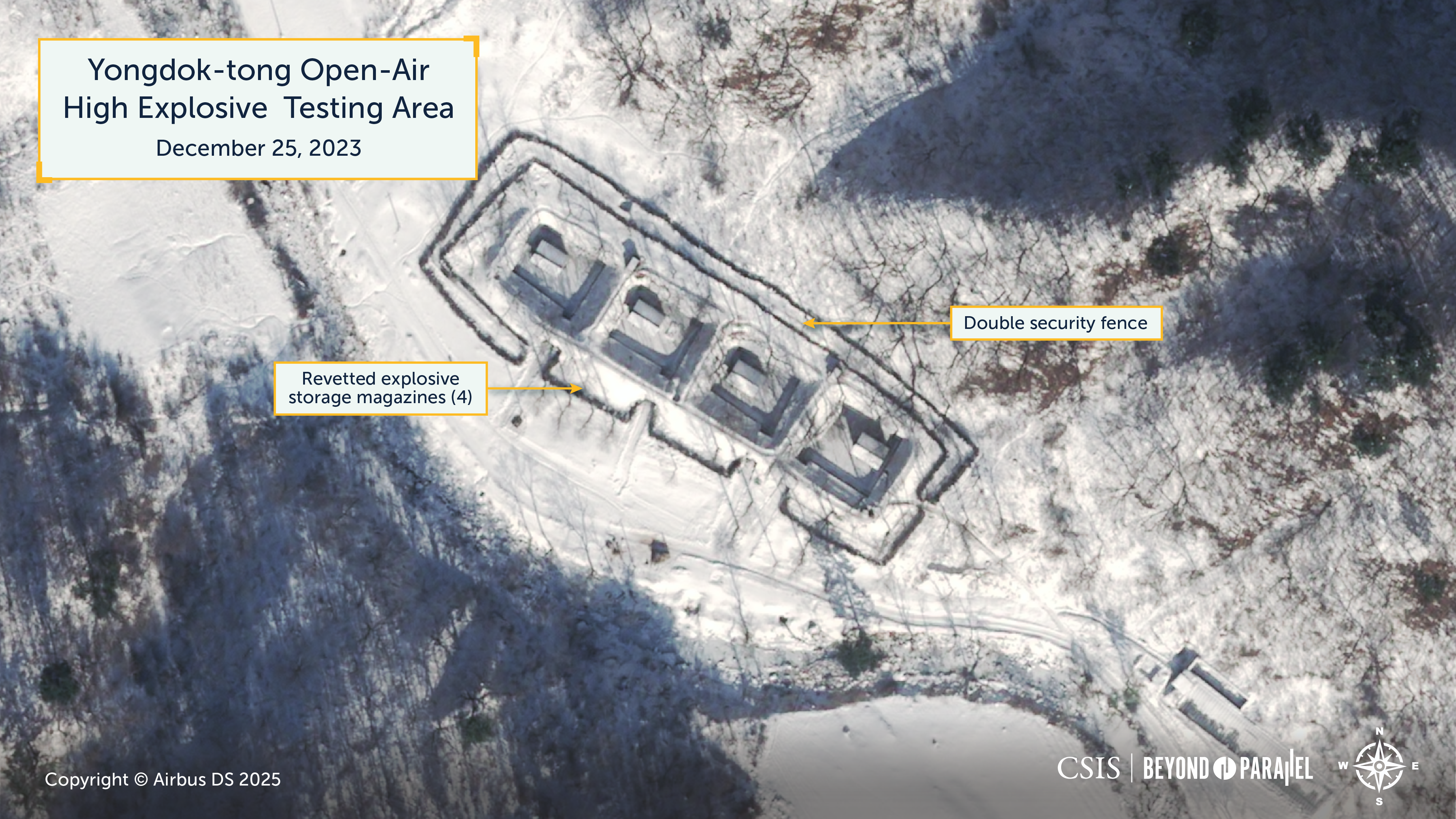
Yongdok-tong Nuclear High Explosive Test Facility: Part 2
This report is the second of a three-part series on the Yongdok-tong Nuclear High Explosive Test Facility, a critical component in the research, development, test, and evaluation (RDT&E) of North Korea’s nuclear warheads. It also serves as the most comprehensive report of the facility currently available at the unclassified level.1 Part 1 provides an overview of the facility and its development history from the 1980s to the 2000s. Part 2 discusses the development history from the 2010s to the present, and Part 3 covers the underground facilities at Yongdok-tong and reports of other nuclear high-explosive testing and weapons storage locations elsewhere in North Korea.
2010s: Expansion
Satellite imagery acquired on February 24, 2010, and November 10, 2010, shows that a site was newly excavated on the west bank of the stream approximately 90 meters to the west of the warehouse area. Here, a small area was excavated out of the side of a hill, and a support facility with six buildings was constructed, two of which appear to be steel-arch-roof, Quonset-type sheds cut into the hillside. Such sheds are often used for storing various activities such as heavy equipment storage, sand and gravel storage to prevent freezing during winter, silage for animal feed, and more. Some sources state that these steel-arch-roof sheds are entrances to an underground facility (UGF) (see the UGF section in Part 3).


Right: Close-up view of the new support area and UGF entrance eight months later, on November 10, 2010.
Copyright © 2025 by Maxar Technologies. Image may not be republished without permission. Please contact imagery@csis.org.
A high-resolution satellite image acquired five years later, on December 18, 2015, shows that numerous small changes had occurred throughout the facility. Additionally, the KPA barracks to the west of the facility’s entrance had undergone development and now consisted of nine buildings and a large greenhouse.
The housing area at the entrance to the Yongdok-tong facility has been significantly expanded and now occupies both sides of the stream. The original west side now consisted of 26 housing units of various sizes, and a new section on the east side of the stream contained 26 small housing units. Immediately to the north of this housing section, a new building was built adjacent to the existing large building. Ongoing activity observed to the east of these buildings appeared to be related to agricultural support.
To the north, the headquarters and administration area has had several buildings razed and rebuilt and a new four-story building constructed, bringing the total number of buildings in the area to nine. The main support area immediately north of this location remained active, and the only significant development was that one of the warehouse buildings had been shortened in length. There are now two small compounds east of the motor vehicle maintenance and storage area. The first and older compound consists of two buildings. The second was built sometime between 2006 and 2010 and consists of a single building. Both show no significant changes. The facility’s electricity substation also remains unchanged.
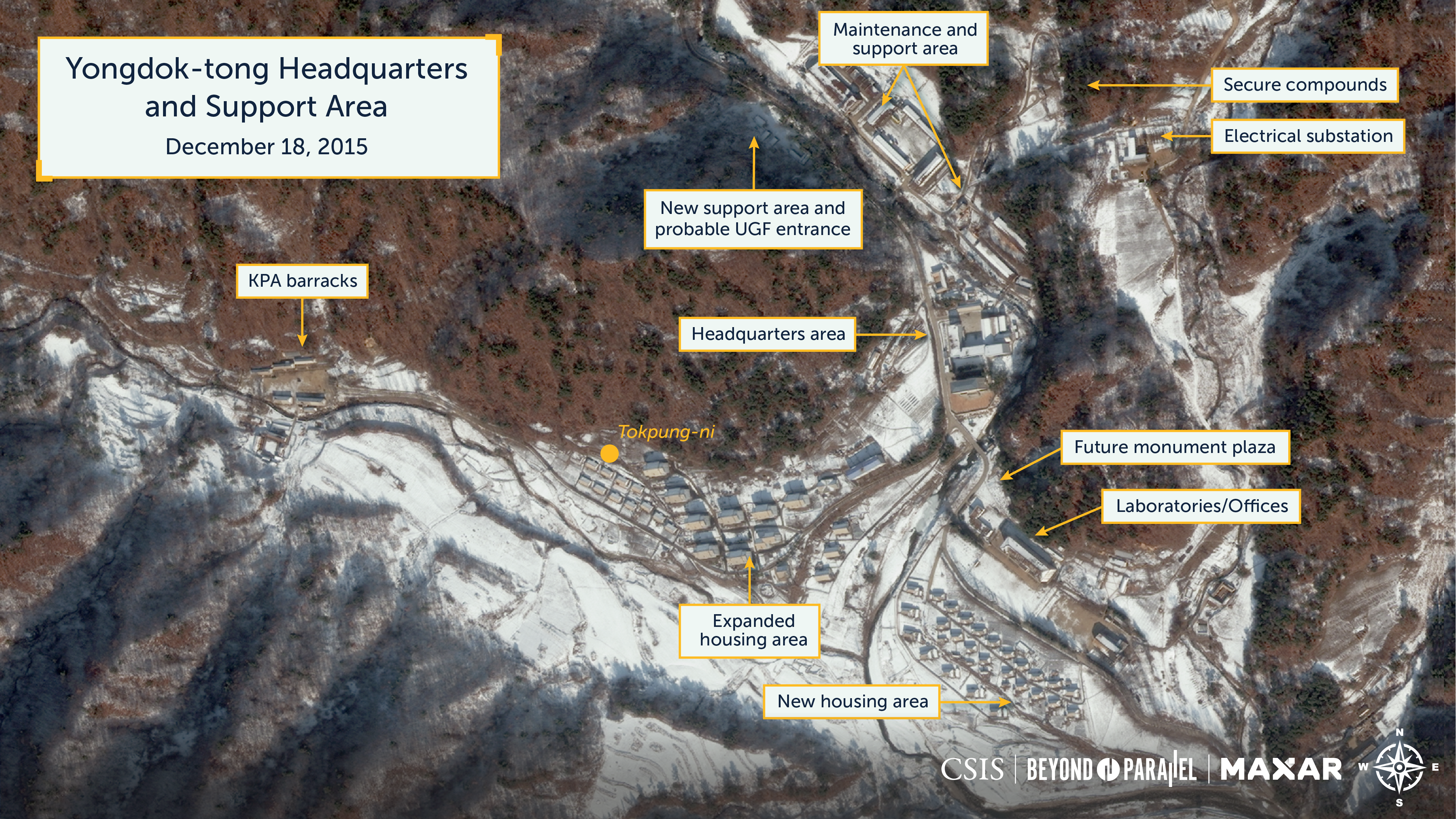
At the revetted support compound across the stream to the west of the warehouse area, only minor changes are observed. A short distance north of this compound is the area containing a revetted laboratory/office building and empty revetments. Two concrete pads were added here between 2003 and 2010.


Right: The revetted laboratory/office compound north of the headquarters and administration area showing a new building and the first indications of a new fence line, December 18, 2015.
Copyright © 2025 by Maxar Technologies. Image may not be republished without permission. Please contact imagery@csis.org.
Further up the valley from the main support area is the explosives storage and fabrication area on the east bank that remains active as indicated by the tracks in the snow. No significant changes have been observed among the various structures or revetted explosive storage magazines since the December 18, 2010, image.
Moving a short distance further up the valley on the east side of the stream is the entrance to the narrow branch valley with a small remote support facility containing five structures. Sometime between 2012 and 2013, an area at the upper end of this valley was excavated, and a warehouse-type building was erected. Some sources would later speculate that a UGF entrance is located here (see Part 3).


Right: The remote support area a short distance north of the explosives storage and fabrication area now showing the presence of six buildings, December 18, 2015.
Copyright © 2025 by Maxar Technologies. Image may not be republished without permission. Please contact imagery@csis.org.
Approximately 475 meters further up the main valley is the open-air, high-explosive testing area with a third revetted explosive magazine. The area remains active, as indicated by tracks in the snow, personnel and equipment in the KPA compound, and minor changes among some small buildings. No craters from potential open-air, high-explosive testing are apparent in the cultivated fields on the west bank of the stream. This would appear to confirm the earlier South Korean Ministry of National Defense announcement on September 10, 2015, that “…North Korea has not conducted any high explosive tests this year.”2
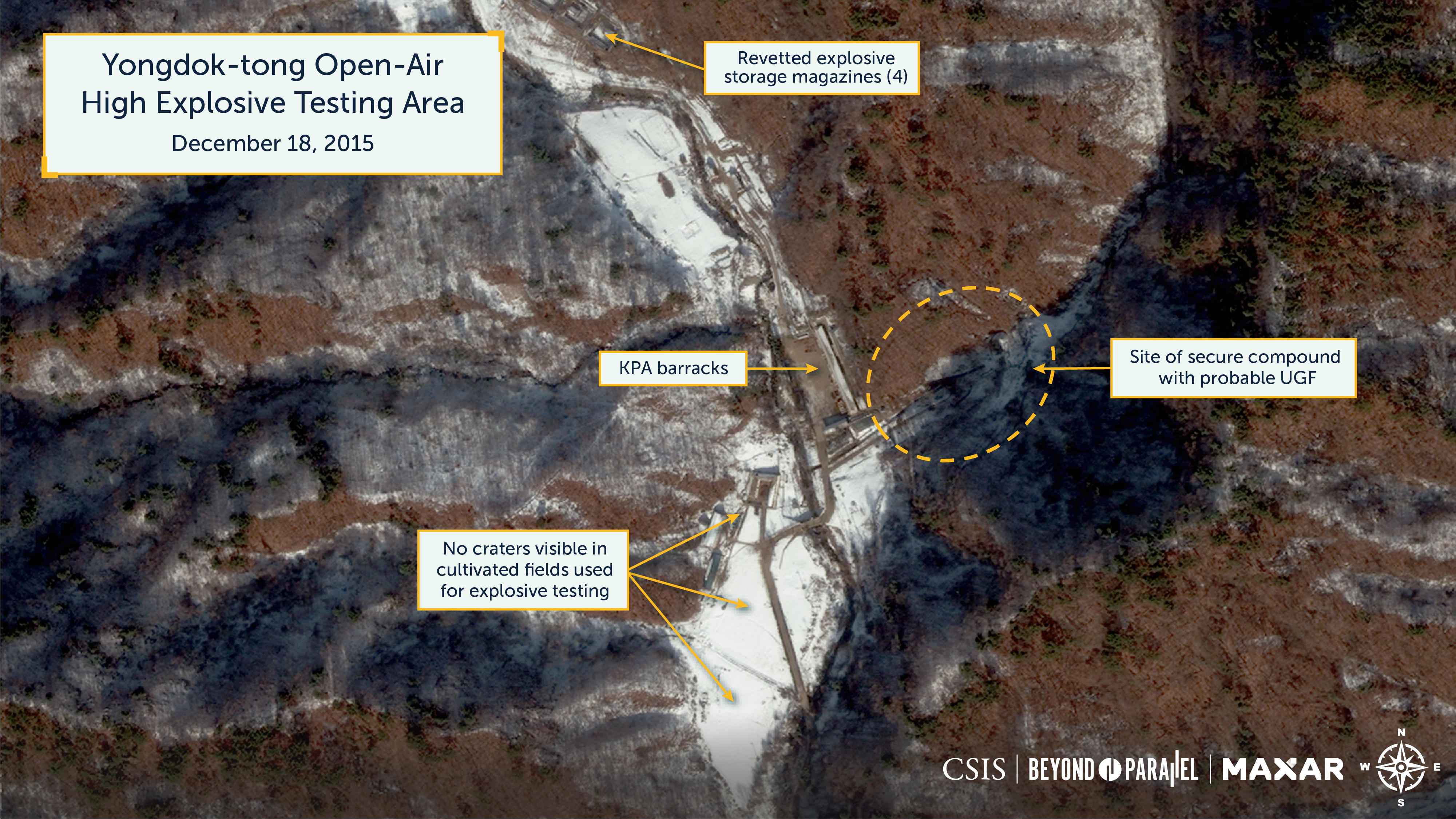
A dirt road extends from this area up a second branch valley to the northeast that contains a small, remote support facility. It was here that some minor excavation was previously observed. It appears that sometime during 2015, a fence was erected to encompass the area. Although details are unclear due to the off-nadir angle, trees, and shadows, it now appears as if there is an entrance to a small bunker or UGF entrance on the east-southeast side of the compound. (see Part 3).
The only activities observed higher up the facility’s primary valley are a few agricultural support facilities, with one exception. This exception is that sometime between 2012 and 2013, a small, approximately 95-meter-long dirt road running east-west was cut into the northern side of a small ridge at the top end of the valley. A small area may have also been cleared at the end of the road. Due to seasonality, shadows, and image off-nadir angle, this road and clearing are not visible in many subsequent satellite images.


Right: Ongoing agricultural activity and new road at the northern end of the Yongdok-tong facility, February 24, 2010. Copyright © 2025 by Maxar Technologies. Image may not be republished without permission. Please contact imagery@csis.org.
The increased number of the facility’s housing units present, expansion of the headquarters and administration area, and activity at and around the explosives storage and fabrication area all indicate that the Yongdok-tong facility remained operational through the December 18, 2015, image.
The following year, in early March 2016, Kim Jong-un met with scientists and technicians working on the development of nuclear weapons.3 During this meeting, Kim received a briefing on “research conducted to tip various type tactical and strategic ballistic rockets with nuclear warheads and acquainted himself with the specifications and mechanism of the miniaturized powerful nuclear warheads.” He was also photographed examining what appears to be the miniaturized nuclear physics package for a warhead that could conceivably be mounted on an intercontinental ballistic missile (ICBM). He reportedly stated that “nuclear warheads have been standardized to be fit for ballistic rockets by miniaturizing.”4 However, South Korean and U.S. officials expressed some doubts about whether North Korea was truly making progress in developing miniaturized warheads.5 Regardless of whether the physics package was real or a mockup, the report and photographs that accompanied it demonstrate the strong intention and direction of ongoing research efforts by North Korea to develop miniaturized nuclear warheads. This research effort was undoubtedly facilitated by the ongoing work being undertaken at the Yongdok-tong facility.

The following year, in early September 2017, Kim Jong-un gave guidance on nuclear weaponization to senior officials of the Department of Munitions Industry of the Central Committee and scientists from the Nuclear Weapons Institute before receiving a briefing on the details of nuclear weaponization. He was photographed in front of what may be a physics package for a two-stage thermonuclear warhead during this meeting.6 How or if these two designs were influenced by work undertaken by the Yongdok-tong Nuclear High Explosive Test Facility is unknown.
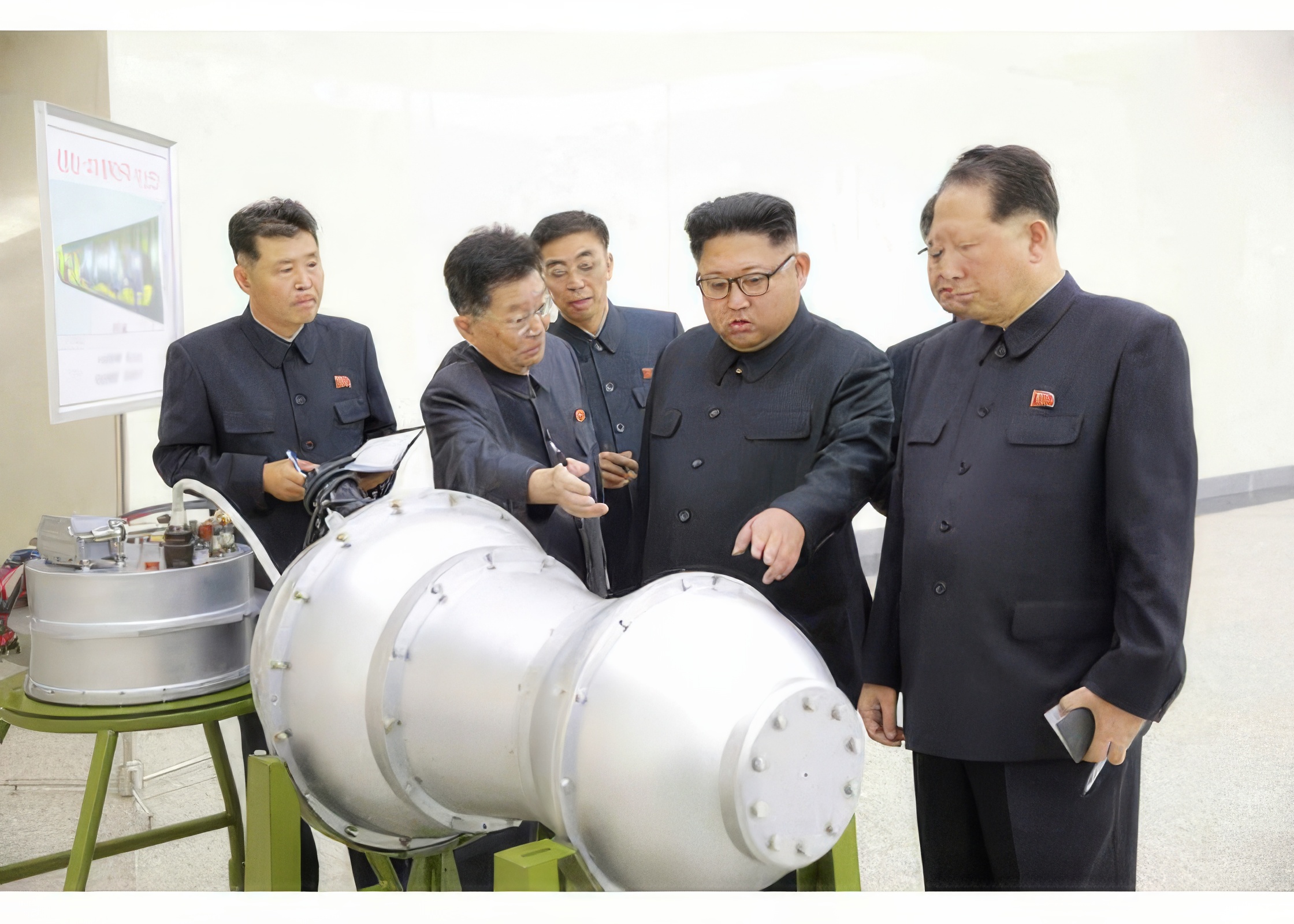
2020s: Continued Activity and Development
Four years later, an image collected on January 9, 2021, shows that the Yongdok-tong facility remained operational and that there were minor infrastructure changes throughout the facility. Additionally, the KPA barracks to the west of the facility’s entrance had undergone additional development and now consisted of ten buildings and 4 greenhouses of different sizes.
The housing areas at the Yongdok-tong facility’s entrance have continued to expand. The housing facility on the west side of the stream was expanded with the construction of four new buildings, the largest of which appears to be a guesthouse for visiting personnel built sometime between 2017 and 2018, along with two large greenhouses, bringing the total number of housing units to 30. The housing area on the east of the stream remained unchanged, consisting of 26 housing units. A footbridge connecting the east and west housing areas was built over the stream in front of the new guest house sometime between 2017 and 2018. Subsequently, during mid-2021, a small dam was also built across the stream in front of the guesthouse. It is unclear whether there are any small hydroelectric generators within the dam. Between 2016 and 2017, the smaller building on the east side of the stream was razed, and the foundation was repurposed as gardens. Immediately to the north, a monument plaza was built with a monument wall and tower. Such plazas have often been used to commemorate visits by the nation’s leaders, although no such visit was announced in North Korean media. On the east bank, ongoing construction on the eastern side of the laboratory/offices building appears related to agricultural support activities.
The January 9, 2021, image shows the headquarters and administration area and main support area immediately to the north are largely unchanged. Both areas are active, with personnel and vehicles present. The first of the two small compounds to the east of the main support area has been expanded and now consists of four buildings and two greenhouses. The second compound to the east of this has also been expanded and now consists of five buildings. The nearby electricity substation remains unchanged.
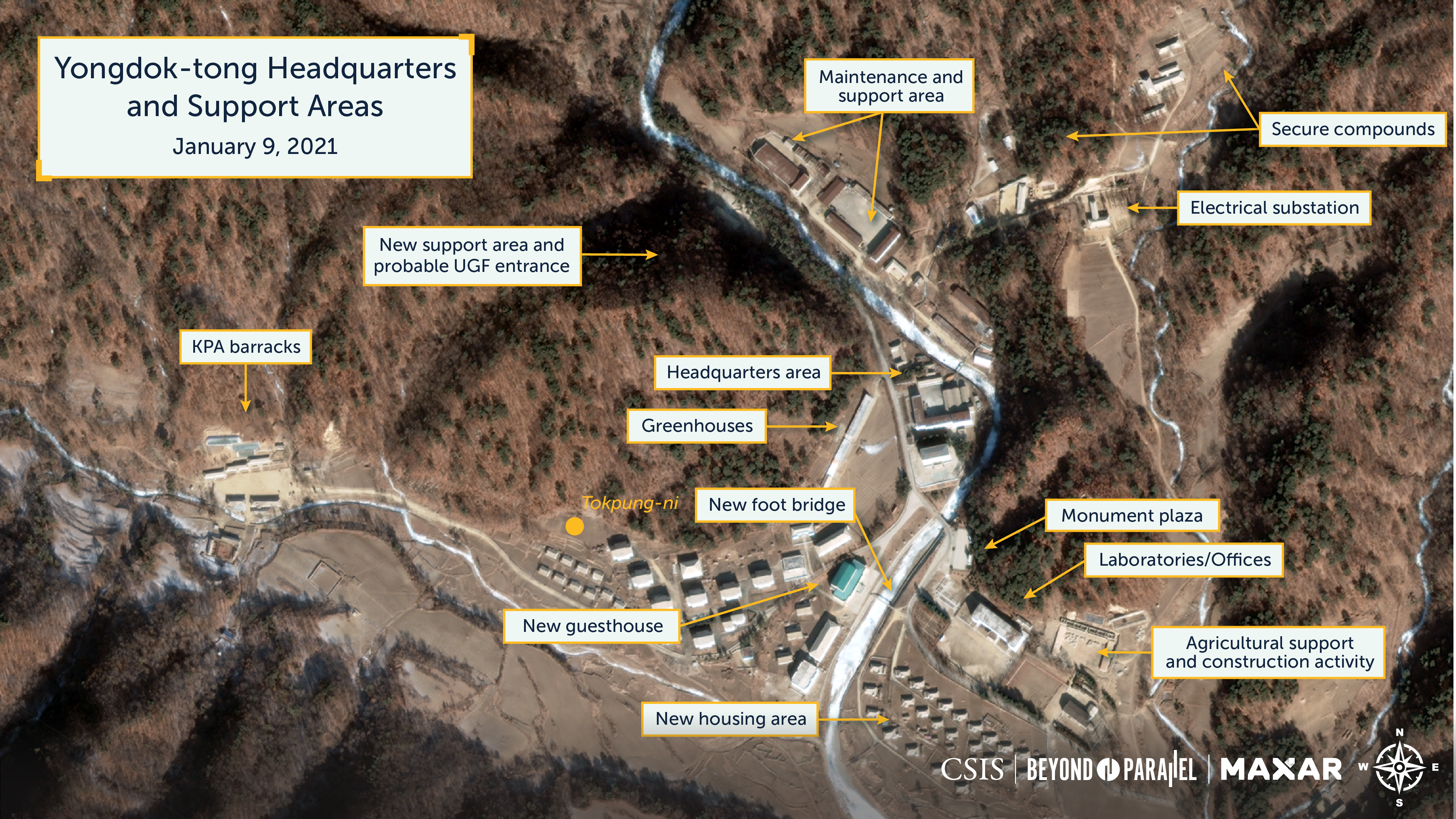
The revetted support compound, situated 90 meters west of the warehouse area and along the west bank of the stream, underwent significant changes in 2020 when the five structures previously located here were razed and replaced by a single larger building. That is clearly visible in a December 25, 2023, image. Several sources suggest that the new larger building now obscures a UGF entrance (see Part 3).
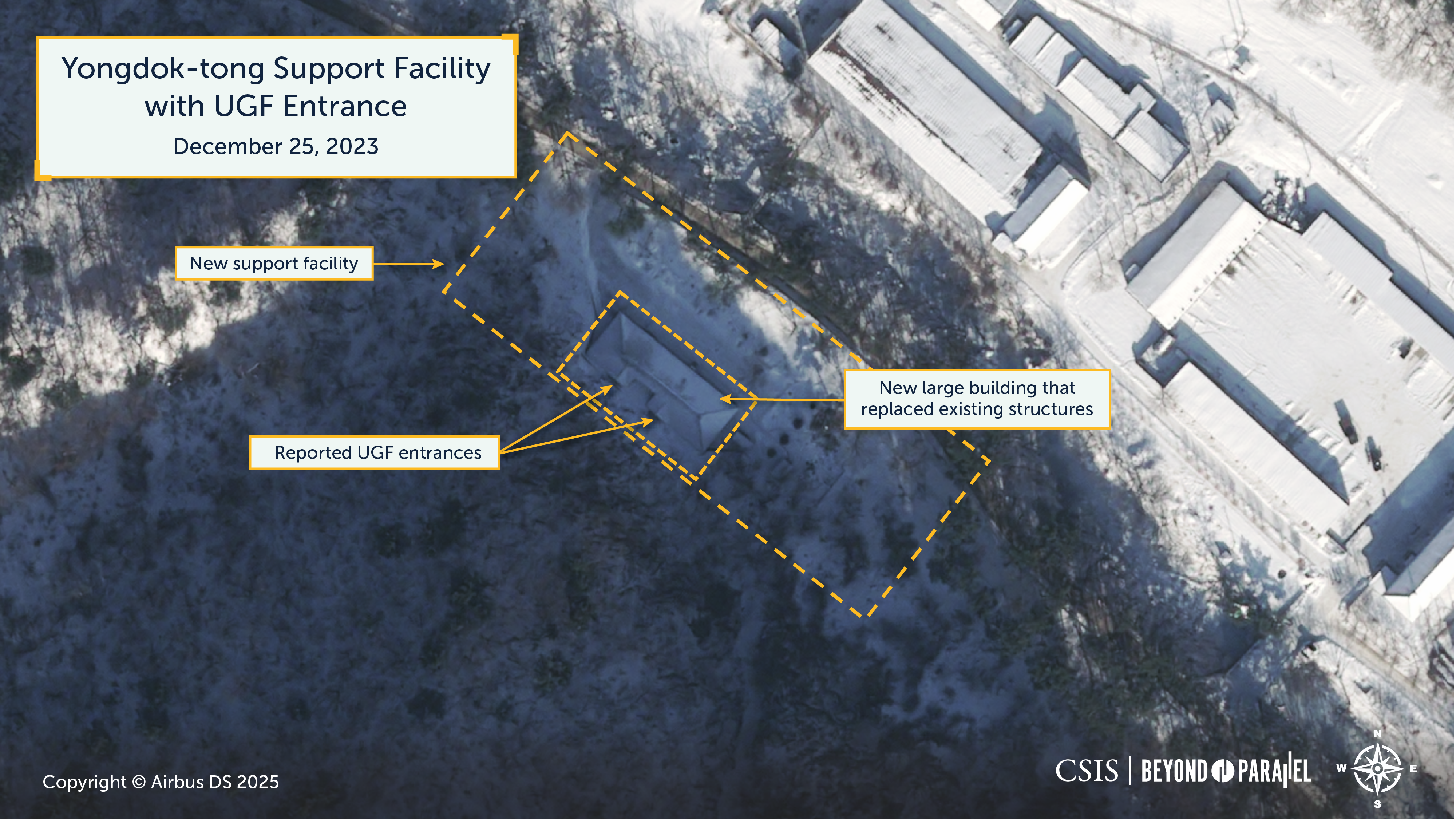
A short distance further up the valley is the area with two buildings partially surrounded by revetments and several empty revetted positions. While this area was likely previously surrounded by some type of fence, it was only in the 2021 image that a recently installed security fence became visible. Subsequently, two additional small buildings were built, and a second security fence was installed sometime between 2021 and 2023. The increased security and additional buildings suggest a need for greater security, a new and more sensitive project in progress, or a combination of these and other factors.


Right: A December 2023 image shows that expansion of the revetted laboratory/office buildings area has continued with the addition of two new buildings and what appears to be a second fence line being installed, December 25, 2023. Copyright © Airbus DS 2025.
Image may not be republished without permission. Please contact imagery@csis.org.
Further up the valley, the explosives storage and fabrication area remain active, as indicated by the presence of vehicles and personnel. Additionally, between 2017 and 2019, a building was razed and replaced by a larger one and a greenhouse. In a December 25, 2023, image, nothing significant is observed among the various revetted explosive storage magazines in this area. Likewise, no changes of significance are observed among the five buildings, water storage tank, and probable pumphouse in the remote support facility north of the explosives storage and fabrication area.
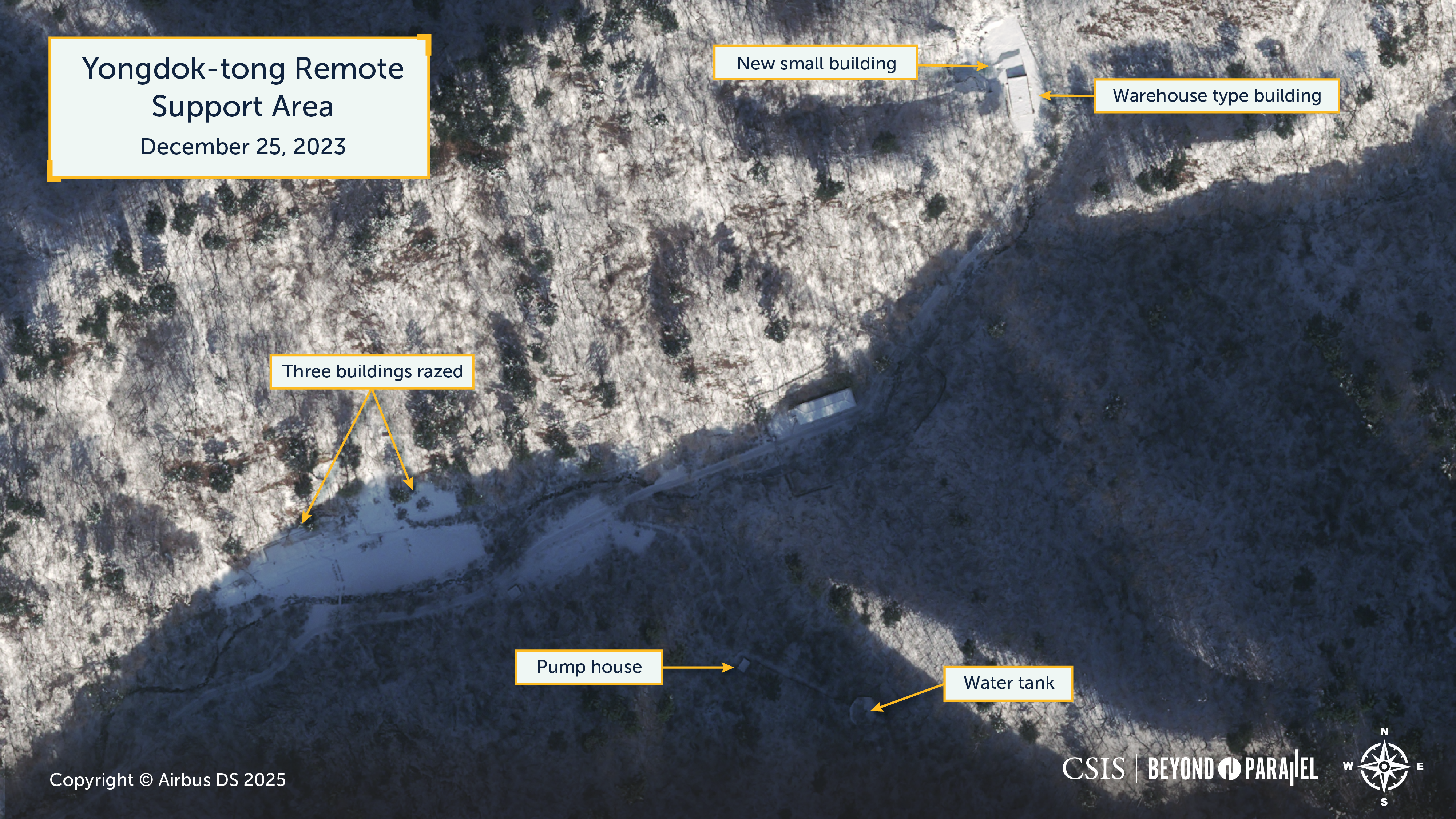
At the open-air high-explosive testing site further up the valley, similar to the earlier 2015 image, only minor changes among some small buildings in the December 25, 2023, image. The KPA barracks compound and the third high-explosive storage area with four revetted magazines remain unchanged. Likewise, no craters from recent potential high-explosive detonator tests are observed.


A fence has been installed around the remote support area extending northeast from the barracks compound, with a small, shed-type building erected inside the area. As with the earlier 2015 image, the December 25, 2023, image is challenging to see details within this area due to the off-nadir angle, shadows, and trees. While this area was likely previously surrounded by some type of fence, it was only in the 2021 image that the fence line became recently apparent. A double security fence is clearly visible in the image.
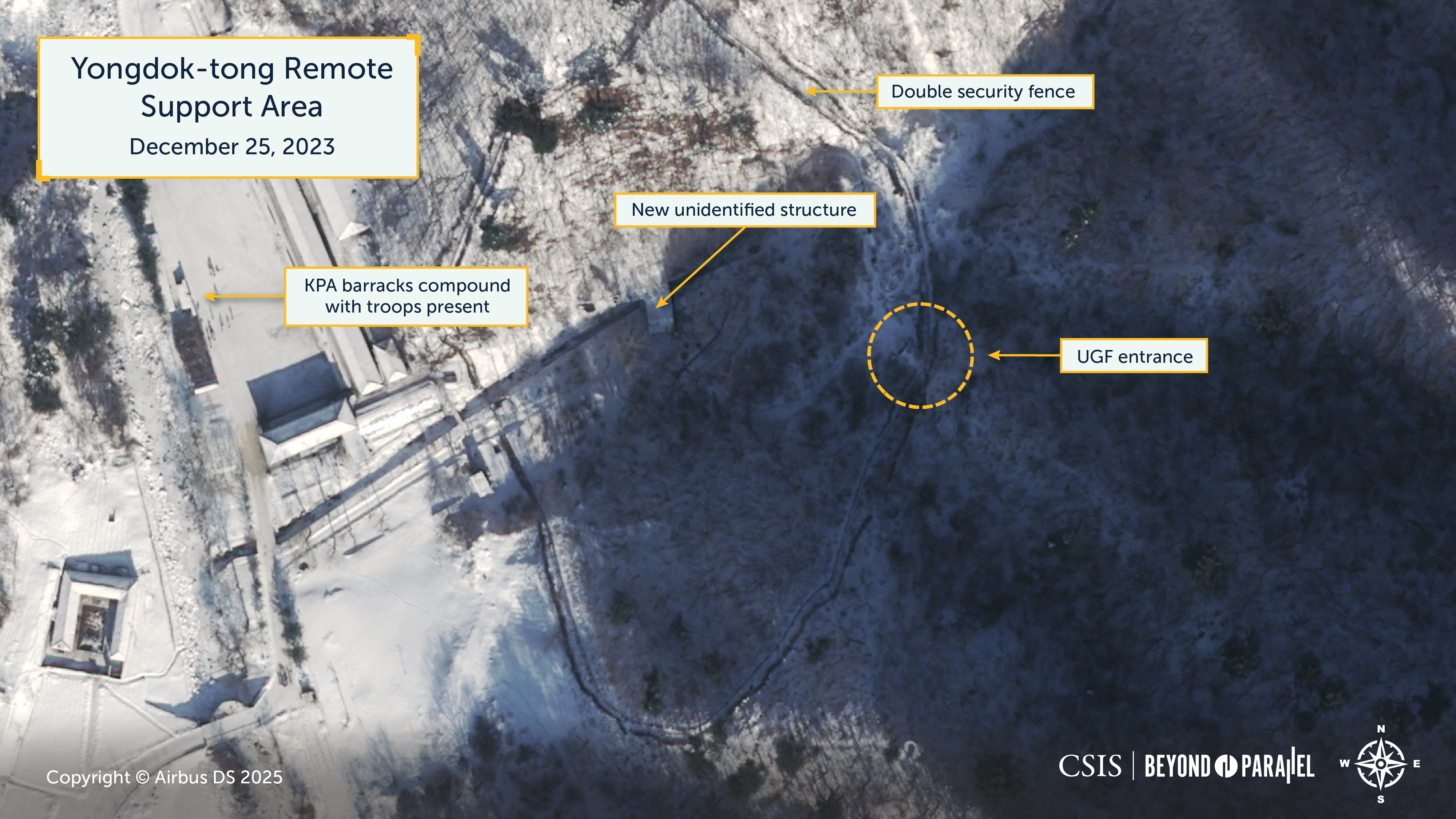
As previously observed, most activities observed higher up in the valley continue to consist of small agricultural facilities in a December 25, 2023, image. Once again, the only exception is the dirt road first observed in the earlier December 18, 2015, image. Additionally, the December 25, 2023, image shows that this road now extends approximately 100 meters to a partially cleared area with one or two buildings.

On March 28, 2023, Kim Jong-un once again provided guidance on nuclear warheads to senior officials of “the Central Committee of the WPK, and other officials of the Department of the Munitions Industry of the Party Central Committee and officials of the Nuclear Weapons Institute and the Missile General Bureau.”7 Kim was photographed in front of what appears to be a single-stage implosion nuclear warhead during this event.8 How this design was influenced by work undertaken by the Yongdok-tong Nuclear High Explosive Test Facility is unknown.
2025: The Facility Today
A more recent image acquired on January 10, 2025, shows that the Yongdok-tong Nuclear High Explosive Test Facility remains operational with continued infrastructure changes, ongoing vehicle movements, personnel and agricultural activity, and an increase in secured facilities. Also visible are what appear to be two small craters in the area reportedly used for open-air, high-explosive testing. The KPA barracks to the west of the facility’s entrance remain operational, as indicated by minor changes typically observed at similar facilities elsewhere in North Korea.
The housing area at the entrance of the Yongdok-tong facility has continued to develop. Sometime during the latter half of 2023, eleven of the smaller housing units on the west side of the stream were razed, leaving only the foundations visible in the 2025 image. It is unclear why these foundations haven’t been completely replaced or removed. Two additional large greenhouses have also been built on the west side of the stream, bringing the total here to four. This increase in greenhouses suggests several purposes, including the need to feed a large workforce, the desire to provide valued scientists, technicians, and workers with a higher standard of living, or a decline in the food supplies being provided to the facility.
The housing area east of the stream remained unchanged, comprising of 26 housing units. The two housing areas contain 45 housing structures, including one large guesthouse. This total does not include the three-story building on the east side of the stream that is likely being used as laboratories/offices. To the east of this building, the construction identified in the 2021 image was completed by the end of that year, including one large and one small agricultural-related buildings and a small greenhouse. The small gardens built on a former building foundation between 2016 and 2017, located to the west of the large building, have now been replaced in 2024-2025 by a more formal garden and monument wall.

Moving north, the headquarters, administration, and main support areas largely remain unchanged, although a small, shed-type building was added to the latter. Vehicles or shipping containers are observed at both locations. No significant changes are observed at the two small secure compounds east of the motor vehicle maintenance and storage area. The nearby electric substation remains unchanged.
Although partially hidden by shadows, the revetted support compound, located 90 meters west of the warehouse area on the west bank of the stream, does not appear to have undergone any significant changes since the 2021 image.
The area approximately 400 meters up the valley from the warehouse area on the west side with the laboratory/office building and warehouse-type building has been expanded with two new buildings added between 2021 and 2023. A security fence encloses them, and a second security fence is currently being added. Several empty revetted positions remain.
Moving north, the explosives storage and fabrication area remains active, as indicated by the rebuilding of one large building and the expansion of another building in the area.9 No significant changes are observed at any of the revetted explosive storage magazines. Two buildings have been razed within the remote support facility’s narrow branch valley north of the explosives storage and fabrication area.
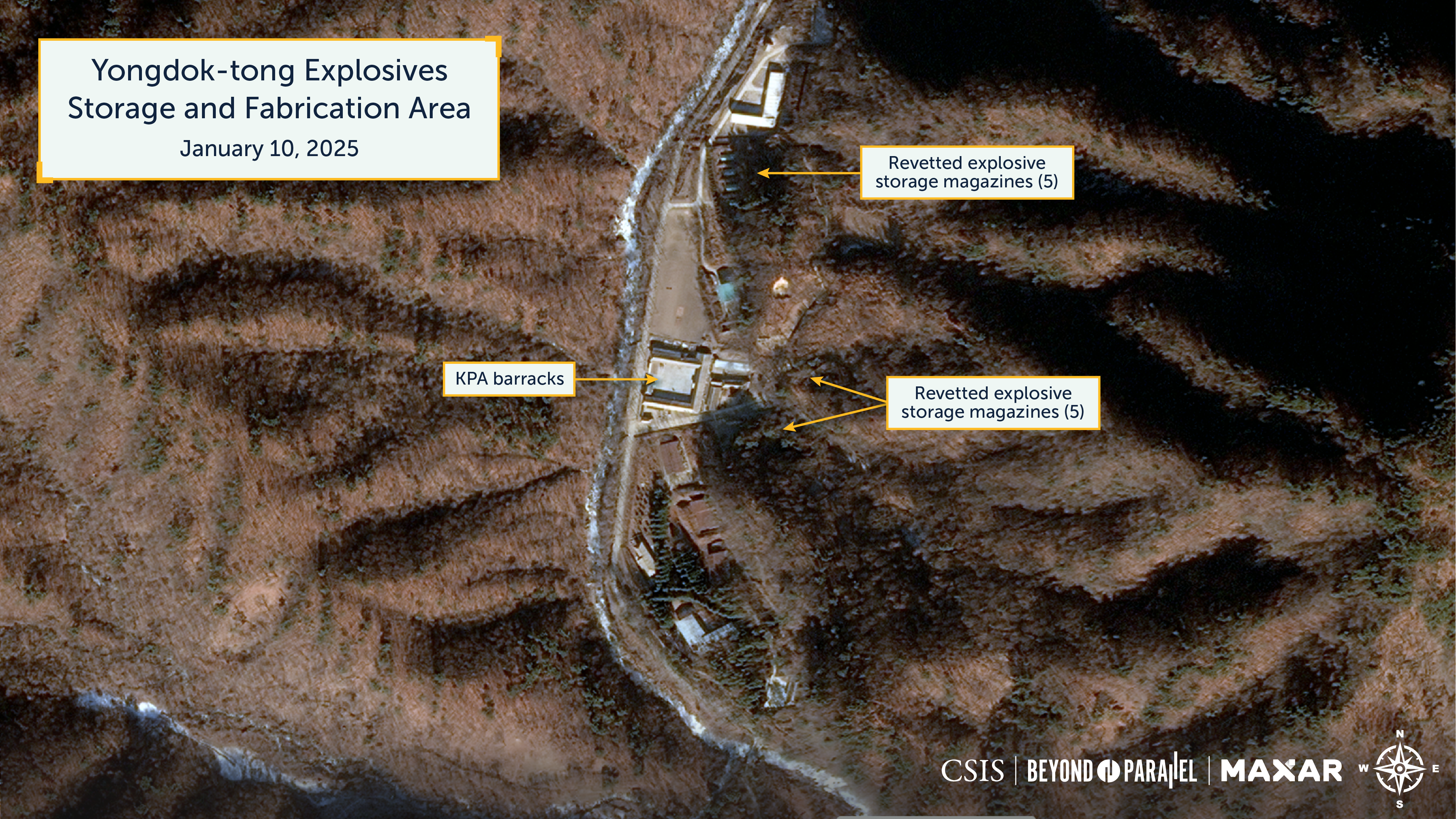
At the open-air, high-explosive testing area further up the valley, the 2025 image shows what appear to be two small craters in the cultivated fields. However, it can’t be determined whether these have been used for recent high-explosives testing or agricultural activity. Within the KPA barracks compound, troops in several formations are observed. No other significant changes are observed here or at the third high-explosive storage area.10 Nothing significant can be observed within the small remote support facility located in the branch valley that extends to the east of the area.
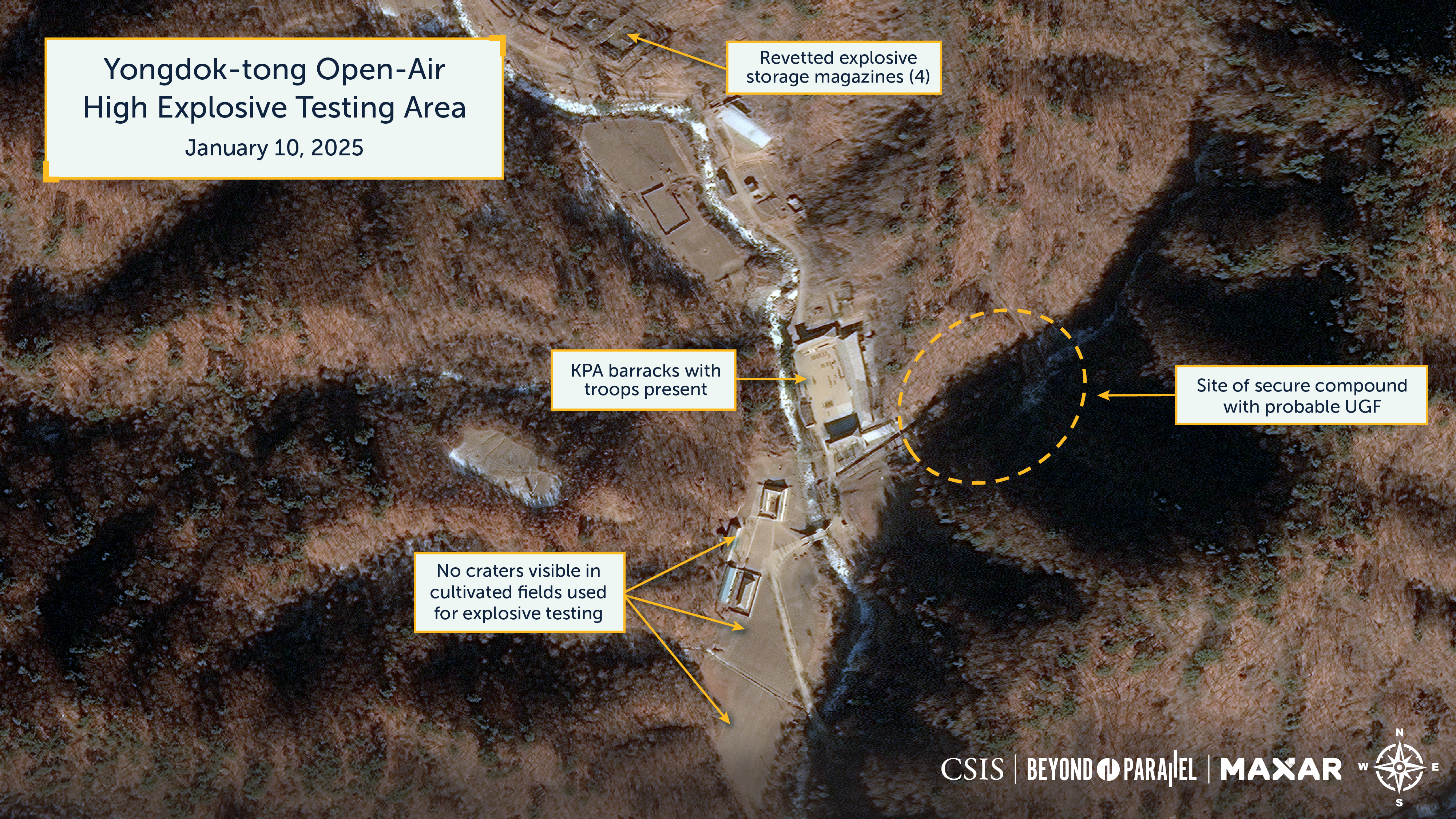
While small changes are observed at some of the small agricultural support facilities further up the valley, these are typical of other facilities in the Kusong area. Due to seasonality, shadows, and the off-nadir angle of the 2025 image, no additional activity is observed along the dirt road first seen in a December 18, 2015, image.
This report is the second of a three-part series on the Yongdok-tong Nuclear High Explosive Test Facility, a critical component in the research, development, test, and evaluation (RDT&E) of North Korea’s nuclear warheads. Part 1 provides an overview of the facility and its development history from the 1980s to the 2000s. Part 2 discusses the development history from the 2010s to the present, and Part 3 will cover the underground facilities at Yongdok-tong and reports of other nuclear high-explosive testing and weapons storage locations elsewhere in North Korea.
References
- The national designator of Yongdok-tong facility is currently unknown at the unclassified level, and it is not known to have been mentioned in North Korean media. As with most North Korean military units, major industrial, and weapons design entities, the Yongdok-tong facility likely has both official and cover designations. The latter is what is commonly seen being used in North Korean media for many entities. For example, a fictional entity mentioned in Rodong Sinmun might have a cover designation of “Agricultural Research Station 918”; however, its official designation could be the “602 Laboratory.” Some entities also have an honorific name appended to their official designation in recognition of some significant accomplishment or personality. Using the example of the “Agricultural Research Station 918” it could also be known as the “Hwang Yong-do 602 Laboratory.” To make this more complicated, it is not unusual for a cover designation to be randomly changed. To ease readability, this report will use the title of “Yongdok-tong Nuclear High Explosive Test Facility” or simply “Yongdok-tong facility.” ↩
- Kim Gwi-geun. “North Korea did not conduct a high explosive test this year,” Yonhap September 10, 2015, https://www.yna.co.kr/view/AKR20150910135251043?section=search ↩
- “Kim Jong Un Guides Work for Mounting Nuclear Warheads on Ballistic Rockets,” Rodong Sinmun, March 9, 2016. ↩
- Ibid. ↩
- “N. Korea says it has miniaturized nuclear warheads,” Yonhap, March 9, 2016, https://en.yna.co.kr/view/AEN20160309001354315?section=search; and Kim To-Il. “Is Kim Jong-un’s ‘miniaturized nuclear warhead’ credible?… ROK military says, “Miniaturization is close,” Yonhap, March 9, 2016, https://www.yna.co.kr/view/AKR20160309031700014?section=search. ↩
- “Kim Jong Un Gives Guidance to Nuclear Weaponization,” Rodong Sinmun, September 3, 2017; and Hans M. Kristensen, Matt Korda, Eliana Johns & Mackenzie Knight. “North Korean nuclear weapons,” Bulletin of the Atomic Scientists, 2024, 80:4, 251-271, https://doi.org/10.1080/00963402.2024.2365013. ↩
- “Respected Comrade Kim Jong Un Guides Work for Mounting Nuclear Warheads on Ballistic Missiles. Rodong Sinmun, March 28, 2023. ↩
- “Kim Jong Un Gives Guidance to Nuclear Weaponization,” Rodong Sinmun, September 3, 2017; and Hans M. Kristensen, Matt Korda, Eliana Johns & Mackenzie Knight. “North Korean nuclear weapons,” Bulletin of the Atomic Scientists, 2024, 80:4, 251-271, https://doi.org/10.1080/00963402.2024.2365013 ↩
- UNSC Report of the Panel of Experts, United Nations Security Council (New York: March 7, 2023), p. 8, https://www.iaea.org/newscenter/focus/dprk/iaea-reports. ↩
- Ibid. ↩

